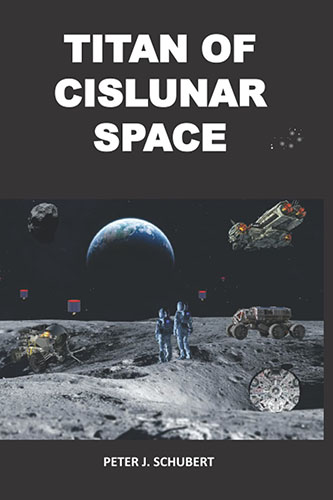Category: Fiction
Reviewed by: Casey Suire
Title: Titan of Cislunar Space
Author: Peter J. Schubert
NSS Amazon link for this book
Format: Paperback/Kindle
Pages: 497
Publisher: G-minus
Date: May 2021
Retail price: $11.99/$7.99
ISBN: 978-1737331001
Cislunar space loosely covers the region between geosynchronous orbit (about 22,236 miles above Earth) and lunar orbit. This unique area figures prominently in the novel Titan of Cislunar Space by Peter J. Schubert, a former member of the NSS Board of Directors. This is the first novel of the author’s trilogy on Space Resources.
The book’s main character, Parks Vambolent, has very strong ambitions of developing space resources. Despite his obvious brilliance, Vambolent has a difficult time realizing his dream of becoming a “titan of cislunar space.” At various points in the novel, he is arrested, shot at, has marriage issues, and fights with a villainous character named Winnimer Jenks. In between these unfortunate incidents, there are some bright spots in his life. For instance, Vambolent works with a reorganized NASA (dubbed NASA-lite) on a crewed lunar program. The constant plot twists and changes in fortune are a major feature of the book.
Titan of Cislunar Space can be classified as a techno-thriller novel. Lots of different space technologies are described in great detail. There are solar power satellites, commercial spaceports, and several rocket launches. There is even a lunar railway system. While many space engineers have proposed such a concept, the book credits the idea to Park’s wife, Elise. As in real life, the novel involves an interesting mix of both NASA and several private space firms. Instead of real companies like SpaceX and Blue Origin, however, the novel has fictitious space ventures with names like Marcharelli Space, StarSys, and LunarSource. Parks Vambolent has his own company called Vambolent Space Industries (later renamed Vambolent Interspace Industries).
From start to finish, Vambolent’s work takes him all over the world. This makes Titan of Cislunar Space a globetrotting adventure to many interesting and somewhat unusual places for a space novel. For example, instead of familiar locations such as Cape Canaveral or the Baikonur Cosmodrome, rocket launches occur from the San Marco Equatorial Range (SMER) in Kenya. While many readers might believe this is a fictitious facility, a Google search reveals this was a real launch site that was last used in 1988. There are also rocket launches from Oklahoma. This too might be dismissed as fiction by some readers. However, Oklahoma actually does have a spaceport license from the FAA. Another notable setting is Purdue University in West Lafayette, Indiana. This isn’t surprising since Dr. Schubert is a Professor of Electrical and Computer Engineering at the university. His admiration for both Purdue and the surrounding area is very evident when reading the book.
Several chapters of Titan of Cislunar Space take place on the lunar surface. While exploring a region known as Hyginus Rille, a team of NASA astronauts encounters a host of problems. For example, there is the threat of deadly radiation from the sun in the form of coronal mass ejections (CMEs). There are also moonquakes. When reading about the troubled lunar mission, it’s hard not to think about the events of Apollo 13. As with the Purdue/Indiana connections, Dr. Schubert also appears to apply his background to the Moon scenes when mentioning an actual lunar crater named Schubert. While it is acknowledged that the crater is named for a famous composer, one can’t help but think that this has more to do with the author’s own last name.
While not a major part of the plot, the novel notes that Chinese taikonauts went to the Moon before American astronauts. This is interesting considering that, in real life, China and Russia are working on a proposed lunar base called the International Lunar Research Station (ILRS). Likewise, the United States, along with other countries, has the Artemis program.
Given all the exciting things currently happening in space, it will be interesting to see how works of fiction will influence actual spaceflight. As humans go further into the final frontier, things once considered science fiction will eventually become reality.
© 2023 Casey Suire
Please use the NSS Amazon Link for all your book and other purchases. It helps NSS and does not cost you a cent! Bookmark this link for ALL your Amazon shopping!
NSS index of over 400 book reviews




















